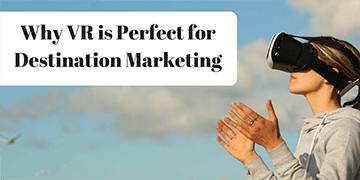
Although it’s easy to dismiss VR as another technological fad, the deciding factor in whether a trend stays or goes will always be what the market wants – and at the moment, it wants VR.
Consumer interest in VR experiences
A 2016 consumer report about VR found that 73.5% of those surveyed listed “travel, tourism, and adventure” as a category of personal interest, highlighting this as the category with the most opportunities for marketers. When it comes to overall interest in VR, a recent report by online retailer Mobiles, found a 300% increase in consumer demand over the past year. This shows that consumers aren’t put off by the current price of VR headsets, something which marketers see as a barrier to using the technology, and therefore an unnecessary investment for commercial use.
The popularity of the low-tech Google Cardboard headsets also shows that consumers are curious about the possibilities of VR, rather than being purely concerned with the top-end technical capabilities of the devices currently available. Consumers are currently more interested in exploring what VR can offer, whether that’s in the form of Google Cardboard or more premium headsets. The only real difference between the two is the level of interactivity the user can engage in, so keeping VR content closer to 360° video makes it more accessible.
If you need any further proof of this, let’s take a look at Google’s latest announcement: the technology giant has revealed a new file format (VR180) in the hope of enhancing the current experience of watching 360° video. When Google gets on board with an emerging technology, you can be sure that it’s not going to fade into obscurity, Betamax-style.
Fuelling the imagination
Successful destination marketing, by nature, relies on your ability to virtually transport people to places by creating campaigns that will tap into their imaginations. This, of course, requires extensive use of imagery to promote destinations, which can otherwise feel intangible to consumers.
Due to this intangible nature, destination marketing has always embraced new technologies that can spark the consumer’s attention. Not only can VR offer people an immersive experience of a destination before they get there, but it can also manage their expectations of it and, overall, help them come to a more informed purchasing decision.
VR is a superb match for the destination industry, because it makes people feel like they are participants rather than viewers. It works perfectly with the concept that destination marketing is about selling an experience and not just a place or attraction.
That said, VR experiences aren’t going to replace effective storytelling and compelling imagery anytime soon – but they can be a useful tool, and it is definitely a technology you should look to explore sooner rather than later. Merging together the capabilities of VR with current storytelling techniques creates a new concept of what storytelling is in the modern technological age.
The role of VR in the customer journey
The key to using VR in destination marketing is knowing which touchpoint in the customer journey to utilise it at.

At the intent/discovery stage, customers will be exploring different options and ideas, so it is essential to capture their attention here. VR is ideal for this, because it taps into their imaginations and allows them to discover destinations in a unique and novel way. It serves the same purpose as other forms of content currently do, but in a far more compelling format.
Offering personalised experiences
These days, people tend to spend as much time planning their holidays as they do enjoying them, if not more. Researching local travel guides, finding the best attractions, and ascertaining the best places to stay, are just some of things people look into before they even set a foot outside their door. Now imagine if you could immerse these people directly into your destination and give them a real feel for it – wouldn’t that be an awesome (literally) way of capturing their interest?
Offering personalised experiences is key in order to stand out from competitors – VR allows users to roam around freely in whatever environment they’re immersed in, making them feel as though they’re able to explore the spaces as they choose.
Creating the illusion of personalised content can really entice your audience in a way that written content and imagery simply can’t. If you’re reading something or watching a video, you know that everyone else will have done so in the exact same way, but with VR you feel as if you are having a unique experience, because you can explore the virtual world at your own pace and as you choose.
The commercial use of VR might not be commonplace yet, but it’s easy to see its appeal in the destination marketing industry. It also seems entirely plausible that in the near future its uptake will widely increase, as the technology continues to become more affordable and more accessible.
If you want to find out more about destination marketing, or you want to have a chat about our other services, get in touch with us today.

